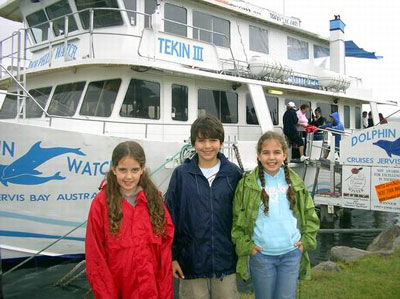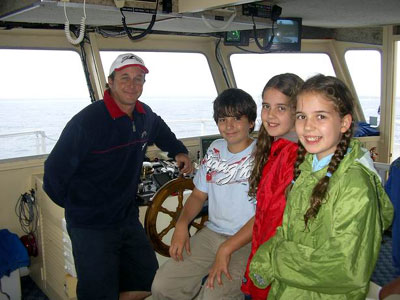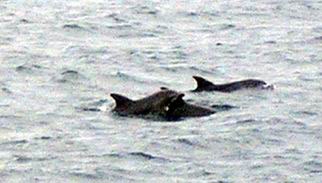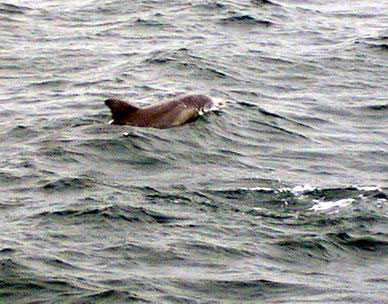 Click To Return To Main Page |
 |
||||||||
 News |
 Eco-Journalists |
 Articles |
 Games |
 Links |
 Facts 'n Fun |
 Email Us |
 About Us |
 Guestbook |
|
|
The Dolphins of Jervis Bay
As usual, the Wadlow family's holiday had a rainy start...and a rainy middle...and a rainy end. But that didn't stop Planet Patrol going forward to find out more about the dolphins of Jervis Bay. About to board the Dolphin Watch cruise
 The dolphins that live in Jervis bay are inshore bottlenose dolphins which means they are the smaller type of bottlenose dolphin which live in shallower waters. Their scientific name is 'tursiops aduncus' They are one of the 35 species of dolphins in Australian waters - they look like they're always smiling because their mouth curves up at the ends.
The dolphins that live in Jervis bay are inshore bottlenose dolphins which means they are the smaller type of bottlenose dolphin which live in shallower waters. Their scientific name is 'tursiops aduncus' They are one of the 35 species of dolphins in Australian waters - they look like they're always smiling because their mouth curves up at the ends.
They look very much like fish, only a lot bigger and without scales and gills. Unlike their fish-like appearance, all dolphins are mammals, (creatures with 'warm blood') and need to breathe air just like us. You may be wondering how dolphins sleep if they need to breathe. Well, dolphins can hold their breath for a lot longer than we can. Also, dolphins don't 'sleep,' they just take 'cat naps.' This is where they rest one side of their brain at a time. Each dolphin can be recognised by their scars and the shape of their dorsal fin (top fin). They live in groups of about 12 dolphins, called 'pods'. Many pods can join-up to form 'herds' which can have hundreds of dolphins in. Bottlenose dolphins eat a variety of foods which includes: fish, squid, octopus and eels. - about eight kg of food a day! Dolphins do not chew their food, they generally eat it whole. So, with our rainjackets at hand, we climbed aboard the 'Dolphin Watch' cruise ship called the Tekin 3. There, we interviewed the Captain of the ship. Chatting to the Captain of the Tekin
 Alastair: We saw a dolphin lying on its back and flapping its tail. What was it doing?
Alastair: We saw a dolphin lying on its back and flapping its tail. What was it doing?Captain: These dolphins will either roll on their backs to catch fish by flicking one in the air and eating it, or to 'socialise' with another dolphin. Me: What kind of dolphins are there in Jervis Bay? Captain: There are two types of dolphins that you could find here, but the Bottlenose dolphins actually live in Jervis Bay whilst the Common Dolphin just 'visit' here. Me: Can the two types of dolphins live together? Captain: I've never seen any problems myself, but I believe that they wouldn't interact as they'd fight for food. Freya: How deep can dolphins dive? Captain: They can actually dive 400 metres deep, but as been as Jervis Bay is only 40 metres deep, they can't dive very deep in this bay. It is determined that around 80 dolphins live permanently in Jervis Bay. We were lucky to be able to see around 15-20 dolphins on the day including a baby dolphin which was swimming with its mum...very cute! Some pictures we took of the dolphins in Jervis Bay
 

Interesting Bottlenosed Dolphin facts:
1. They make squeaking and whistling noises through nasal sacs in their heads which sound slightly different in each dolphin, just as we can be recognised by their voice. I'm an identical twin and even though I look like my sister, my voice sounds different....ok, only a bit and apparently not on the phone!
2. Dolphins also make clicking noises which is the sound that their echo-location system makes...a bit like a ships sonar. It bounces back sound waves off a solid object (like a boat, or another dolphin) and they can tell how far away it is. 3. Bottlenose dolphins can leap up to 6 metres in the air...why? No one knows, but they seem to enjoy doing it. 4. Bottlenose dolphins have a brilliant sense of hearing and have super eyesight in and out of the water...probably to make-up for the fact that they can't smell...a good job really with all that fish they eat! So, what can you do to help these wonderful creatures?
1. Make sure you don't litter as most litter eventually finds its way into our oceans where it can be swallowed or could entangle dolphins and other marine life....even if you live inland!
2. If you go fishing, make sure you retrieve all fishing lines and hooks so they don't get swallowed by marine life. 3. If you want to see the dolphins at play then it's best to go with a proper authorised dolphin cruise ship. This way you absolutely know that you are not stressing the dolphins out as the authorised operators have to stick to very strict guidelines written by the Australian & New Zealand Environment Conservation Council, which are: 1. Only approach dolphins from the side 2. Stay at least 50m away 3. Don't approach if there are any small calves 4. If the dolphins are showing any sign of disturbance, then move away slowly 5. Minimise changing gears and reversing. You also get lots of local knowledge - the Captain knew just which patches of sea grass the dolphins loved to hang out in. We chose to go with Dolphin Watch at Huskisson as we noticed that they printed their brochures on recycled paper and had won an environmental award. It cost us just $93 for our family of 6 to go on a 2 hour cruise which we thought was pretty good. They also do whale watching cruises during Jun-Jul and Sep-Nov which we'd love to do. Don't forget to read Freya's story on how Huskisson banned ALL plastic shopping bags from their town! Story by: Imogen Wadlow
Information sourced from:
Captain of Dolphin Watch Cruises, Huskisson Dolphin Watch Cruises Fact Sheet written by the Marine Mammal Research Group of Macquarie University National Geographic - www.nationalgeographic.com/kids |